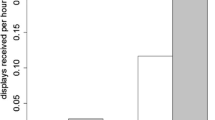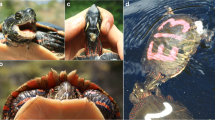Abstract
Same-sex mounting is an aspect of animal behavior that has received increased attention in recent years in an attempt to improve our limited understanding of the possible causal mechanisms. Here, to our knowledge, we review for the first time same-sex mounting in turtles and tortoises. To this end, we have compiled data on same-sex mounts in 13 chelonian species and discuss the data together with those hypotheses most commonly raised in turtle studies, namely, the intrasexual conflict, maladaptation, mistaken identify, and opposite-sex deprivation hypotheses. Compilation of the data revealed that in almost every species with reports of same-sex mounting there were dominance relationships mediated by aggressive/submissive interactions; most of these cases occurred in captivity, and the sex ratios were not skewed. We discuss future research directions, providing initial ideas of experimental testing on each hypothesis, in the hope of directing more research effort to this field.
Similar content being viewed by others
References
Arndt RG (1977) Notes on the natural history of the Bog Turtle, Clemmys muhlenbergi (Schoepff), in Delaware. Chesap Sci 18:67–76
Bagemihl B (1999) Biological exuberance. St. Martin’s Press, New York
Bailey NT, Zuk M (2009) Same-sex sexual behavior and evolution. Trends Ecol Evol 24:439–446
Baker RE, Gillingham JC (1983) An analysis of courtship behaviour in blanding’s turtle, Emydoidea blandingi. Herpetologica 32:166–173
Barlow GW (2000) The cichlid fishes: nature’s grand experiment in evolution. Perseus, New York
Boice R (1970) Competitive feeding behaviours in captive Terrapene c. carolina. Anim Behav 18:703–710
Bulova SJ (1994) Patterns of burrow use by Desert Tortoises: gender differences and seasonal trends. Herpetol Monogr 8:133–143
Cagle FR (1955) Courtship behavior in juvenile turtles. Copeia 1955:307
Correa MLCA, Molina FB, Rocha MB (1988) Descrição da corte e da cópula de Geochelone carbonaria (Spix, 1824), jabuti, em cativeiro, com citação de alguns desvios comportamentais (Testudines: Testudinidae). VI Encontro Anual de Etologia. Universidade Federal de Santa Catarina, Florianópolis, pp 144
Cutuli G, Cannicci S, Vannini M, Fratini S (2014) Influence of male courtship intensity and male-male competition on paternity distribution in Hermann’s Tortoise, Testudo hermanni hermanni (Chelonia, Testudinidae). Biol J Linn Soc 111(656):667
Ewing HE (1935) Further notes on the reproduction of the Eastern Box-Turtle, Terrapene carolina (Linné). Copeia 1935:102
Field KL, Waite TA (2004) Absence of female conspecific induces homosexual behaviour in male guppies. Anim Behav 68:1381–1389
Guix JC, Fedullo DL, Molina FB (2001) Masculinization of captive females of Chelonoidis carbonaria (Testudinidae). Rev Esp Herp 15:67–75
Kaufmann JH (1992) The social behavior of wood turtles, Clemmys insculpta, in Central Pennsylvania. Herpetol Monogr 6:1–25
Kramer M, Burghardt GM (1998) Precocious courtship and play in emydid turtles. Ethology 104:38–56
Lardie RL (1983) Aggressive interactions and territoriality in the yellow mud turtle, Kinosternon flavescens flavescens (Agassiz). Bull Okla Herpetol Soc 8:68–81
Levan KE, Fedina TY, Lewis SM (2009) Testing multiple hypotheses for the maintenance of male homosexual copulatory behaviour in flour beetles. J Evol Biol 22:60–70
Liu Y, He B, Shi H, Murphy RW, Fong JJ, Wang J, Fu L, Ma Y (2008) An analysis of courtship behaviour in the four-eyed spotted turtle, Sacalia quadriocellata (Reptilia: Testudines: Geoemydidae). Amphib Reptil 29:185–195
Liu Y, Wang J, Shi H, Murphy RW, Hong M, He B, Fong JJ, Wang J, Fu L (2009a) Ethogram of Sacalia quadriocellata (Reptilia: Testudines: Geoemydidae) in captivity. J Herpetol 43:318–325
Liu Y, Shi H, Wang J, Murphy RW, Hong M, Yun C, Wang Z, Wang Y, He B, Wang L (2009b) Activity rhythms and time budget of Sacalia quadriocellata in captivity. Herpetol J 19:163–172
Liu Y, Davy CM, Shi H, Murphy RW (2013) Sex in the half-shell: a review of the functions and evolution of courtship behavior in freshwater turtles. Chelonian Conserv Biol 12:84–100
MacFarlane GR, Blomberg SP, Kaplan G, Rogers LJ (2006) Same-sex sexual behavior in birds: expression is related to social mating system and state of development at hatching. Behav Ecol 18:21–33
Mahmoud IY (1967) Courtship behavior and sexual maturity in for species of Kinosternid turtles. Copeia 1967(2):314–319
Marco A, Lizana M (2002) The absence of species and sex recognition during mate search by male common toads, Bufo bufo. Ethol Ecol Evol 14:1–8
McDonald JH (2008) Handbook of biological statistics. Sparky House Publishing, Baltimore
Molina FB (1989) Observações sobre a biologia e o comportamento de Phrynops geoffroanus (Schweigger, 1812) em cativeiro (Reptilia, Testudines, Chelidae). MSc. thesis. Universidade de São Paulo, São Paulo
Molina FB (1992) O comportamento reprodutivo dos quelônios. Biotemas 5:61–70
Molina FB (1996) Mating behavior of captive Geoffroy’s side-necked turtles, Phrynops geoffroanus (Testudines: Chelidae). Herpetol Nat Hist 4:155–160
Munõz A (2004) Chemo-orientation using conspecific chemical cues in the Stripe-Necked Terrapin (Mauremys leprosa). J Chem Ecol 30:519–530
Niblick HA, Rostal DC, Classen T (1994) Role of male-male interactions and female choice in the mating system of the desert tortoise, Gopherus agassizii. Herpetol Monogr 8:124–132
Poiani A (2010) Animal homosexuality: a biosocial perspective. Cambridge University Press, Cambridge
Poschadel JR, Meyer-Lucht Y, Plath M (2006) Response to chemical cues from conspecifics reflects male mating preference for large females and avoidance of large competitors in the European Pond Turtle, Emys orbicularis. Behaviour 143:569–587
Preston-Mafham K (2006) Post-mounting courtship and the neutralizing male competitors through “homosexual” mountings in the fly Hydromyza livens F. (Diptera: Scatophagidae). J Nat Hist 40:101–105
Riener R (2009) Das Fortpflanzungsverhalten der Breitrandschildkröte Testudo marginata Schoepff, 1792, in menschlicher Obhut. Graduation Monography. Universität Wien, Vienna
Rodrigues JFM, Borges-Nojosa DM (2013) Does Kinosternon scorpioides (Linnaeus, 1766) prefer to reproduce in clean water? Herpetol Notes 6:519–521
Rodrigues JFM, Borges-Nojosa DM (2014) Do male Kinosternon scorpioides (Linnaeus, 1766) select and monopolize females? Herpetozoa 26:186–188
Rovero F, Lebboroni M, Chelazzi G (1999) Aggressive interactions and mating in wild populations of the European pond turtle Emys orbicularis. J Herpetol 33:258–263
Shine R, Harlow P, Lemaster MP, Moore IT, Mason RT (2000) The transvestite serpent: why do male garter snakes court (some) other males? Anim Behav 59:349–359
Shine R, Langkilde T, Mason RT (2003) Confusion within “mating balls” of garter snakes: does misdirected courtship impose selection on male tactics. Anim Behav 66:1011–1017
Switzer PV, Forsythe PS, Escajeda K, Kruse KC (2004) Effects of environmental and social conditions on homosexual pairing in the Japanese beetle (Popillia japonica Newman). J Insect Behav 17:1–16
Werner YL (1980) Apparent homosexual behaviour in an all-female population of a lizard, Lepidodactylus lugubris and its probable interpretations. Zeitschrift für Tierpsychologie (Ethology) 54:144–150
Wickler W (1967) Socio-sexual signals and their intra-specific imitation among primates. In: Morris D (ed) Primate ethology. Aldine, Chicago, pp 69–79
Acknowledgments
We thank Flávio de Barros Molina, Rod Preston-Mafham, and John Iverson for kindly scanning and providing manuscripts; Hai-tao Shi for providing unpublished data; Adriano Rodrigues de Paula for kindly helping with interpreting the German in some texts; Kayla M. Peck for kindly reviewing the English of the paper; all the anonymous reviewers that provided interesting suggestions to the manuscript. We also thank Conselho Nacional de Desenvolvimento Científico e Tecnológico (CNPq) and Coordenação de Aperfeiçoamento de Pessoal de Nível Superior (CAPES) for fellowship support during the year of this study.
Author information
Authors and Affiliations
Corresponding author
About this article
Cite this article
Rodrigues, J.F.M., Liu, Y. An overview of same-sex mounting in turtles and tortoises. J Ethol 34, 133–137 (2016). https://doi.org/10.1007/s10164-015-0456-2
Received:
Accepted:
Published:
Issue Date:
DOI: https://doi.org/10.1007/s10164-015-0456-2




